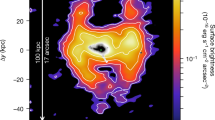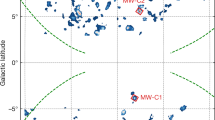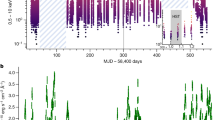Abstract
TO explain why the progenitor of supernova 1987A exploded as a blue supergiant star, models of stellar evolution require that there must have been extensive mixing into the hydrogen-rich envelope of materials from deeper, helium-rich regions1–3. Estimates of the helium abundance in the outer layers, which can be obtained from infrared spectroscopy of the stellar wind from the progenitor, can help to determine the extent of the mixing. The initial ultraviolet flash from the surface of supernova 1987A ionized the circumstellar gas to produce narrow emission lines, which were first seen at ultraviolet wavelengths4 where the supernova's photospheric emission quickly faded. Later, optical lines were also reported5. The ultraviolet lines indicated electron densities of ∼104cm−3, far greater than expected for the wind shed by the precursor star, Sk –69 202, in either its blue supergiant or preceding red supergiant phase6. However, the interaction of the two winds could produce a shell of the requisite density7,8. From observations of the infrared helium triplet at 1,083 nm we infer that the red supergiant wind was strongly asymmetric and that part of it had a high helium abundance.
This is a preview of subscription content, access via your institution
Access options
Subscribe to this journal
Receive 51 print issues and online access
$199.00 per year
only $3.90 per issue
Buy this article
- Purchase on Springer Link
- Instant access to full article PDF
Prices may be subject to local taxes which are calculated during checkout
Similar content being viewed by others
References
Maeder, A. ESO Workshop on the Supernova 1987A, Conf. Workshop Proc. 26, 251–269 (1987).
Saio, H., Nomoto, K. & Kato, M. Nature 334, 508–510 (1988).
Woosley, S. E., Pinto, P. A. & Weaver, T. A. Proc. astr. Soc. Aust. 7, 355–370 (1988).
Wamsteker, W., Gilmozzi, R. & Cassatella, A. Int. astr. Un. Circ. 4410 (1987).
Wampler, J. Int. astr. Un. Circ. 4541 (1988).
Fransson, C. et al. Astrophys. J. 336, 429–441 (1989).
Chevalier, R. A. Nature 332, 514–516 (1988).
Chevalier, R. A. ESO Workshop on the Supernova 1987A, Conf. Workshop Proc. 26, 481–494 (1987).
Dopita, M. A., Meapheringham, S. J., Nulsen, P. & Wood, P. R. Astrophys. J. 322, L85–L89 (1987).
Lundqvist, P. & Fransson, C. ESO Workshop on the Supernova 1987A, Conf. Workshop Proc. 26, 495–502 (1987).
Fransson, C. & Lundqvist, P. Astrophys. J. 341, L59–L62 (1989).
Nisensen, P., Papaliolios, C., Karovska, M. & Noyes, R. Astrophys. J. 320, L15–L18 (1987).
Meikle, W. P. S., Matcher, S. J. & Morgan, B. L. Nature 329, 608–611 (1987).
Cropper, M. S. et al. Mon. Not. R. astr. Soc. 231, 695–722 (1988).
Papaliolios, C. et al. Nature 338, 565–566 (1989).
Wood, P. R. & Faulkner, D. J. Int. astr. Un. Circ. 4739 (1989).
Crotts, A. P. S., Kunkel, W. E. & McCarthy, P. J. Astrophys. J. (in the press).
Meikle, W. P. S., Allen, D. A., Spyromilio, J. & Varani, G. F. Mon. Not. R. astr. Soc. 238, 193–223 (1989).
Allen, D., Meikle, P. & Spyromilio, J. Int. astr. Un. Circ. 4747 (1989).
Roche, P. F., Aitken, D. K., Smith, C. H. & James, D. D. Nature 337, 533–535 (1989).
Felten, J. E. & Dwek, E. Nature 339, 123–125 (1989).
Karovska, M., Nisenson, P., Papaliolios, C., Standley, C. & Heathcote, S. Int. astr. Un. Circ. 4749 & 4752 (1989).
Crotts, A. & Kunkel, W. E. Int. astr. Un. Circ. 4753 (1989).
Heathcote, S., Suntzeff, N. & Walker, A. Int. astr. Un. Circ. 4753 (1989).
Osterbrock, D. E. Astrophysics of gaseous nebulae and active galactic nuclei (University Science Books, Mill Valley, 1989).
Jacobs, V. L. & Burke, P. G. J. Phys. B5, 2272–2281 (1972).
Bell, K. L., Kingston, A. E. & Taylor, I. R. J. Phys. B6, 2271–2279 (1973).
Hata, J. & Grant, I. P. J. Phys. B14, 2111–2124 (1981).
Clegg, R. E. S. Mon. Not. R. astr. Soc. 229, 31P–39P (1987).
Clegg, R. E. S. & Harrington, J. P. Mon. Not. R. astr. Soc. 239, 869–883 (1989).
Wampler, E. J. & Richichi, A. The Messenger 52, 14–16 (1988).
Dopita, M. A. Proc. astr. Soc. Aust. 7, 344–351 (1988).
West, R. M., Lauberts, A., Jørgensen, H. E. & Schuster, H.-E. Astr. Astrophys. 177, L1–L2 (1987).
Author information
Authors and Affiliations
Rights and permissions
About this article
Cite this article
Allen, D., Meikle, W. & Spyromilio, J. Helium abundance and asymmetry in the wind from the precursor to supernova 1987A. Nature 342, 403–405 (1989). https://doi.org/10.1038/342403a0
Received:
Accepted:
Published:
Issue Date:
DOI: https://doi.org/10.1038/342403a0
This article is cited by
-
SN 1987A and SN 1993J: Testing stellar evolution theory?
Space Science Reviews (1994)
-
Supernova 1987A at five years of age
Nature (1992)
Comments
By submitting a comment you agree to abide by our Terms and Community Guidelines. If you find something abusive or that does not comply with our terms or guidelines please flag it as inappropriate.



